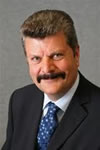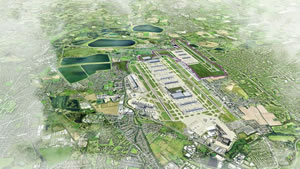EU Pollution Ruling Casts Fresh Doubts Over Heathrow Expansion
NO2 levels at Heathrow breach EU Air Quality Directive
The cross-party 2M Group of councils is warning the Airports Commission and the Government that Heathrow expansion has become even more difficult after the UK’s Supreme Court was given responsibility to enforce EU pollution law.
Nitrogen Dioxide levels at Heathrow and other pollution hotspots across Greater London are currently in breach of the EU Air Quality Directive although Heathrow management say that road traffic from the M4 is primarily responsible.
The UK Government had attempted to avoid a showdown with the EU by producing a pollution action plan which would achieve legal compliance by 2025. The date has since slipped to ‘post 2030’.
Now this plan has been rejected by the Court of Justice of the EU (CJEU) and UK ministers will have to prepare new plans to reduce illegal pollution levels “as soon as possible”.
The CJEU handed responsibility to enforce compliance with air quality law to the Supreme Court. Judges will examine the case next year.
The case was brought to the CJEU by environmental group Client Earth.
The changing legal framework could pose a problem for Heathrow as it seeks permission to expand its operation.
Sir Howard Davies, head of the Airports Commission, and ministers will now have to review the Heathrow proposals in light of the Supreme Court’s new mandate to ensure Nitrogen Dioxide limits are met “as soon as possible”.
The airport’s application to build a third runway would increase annual flights from 480,000 to 740,000. The freight operation would double in size and the number of people using the airport would also double.
The cross-party 2M Group of councils say there is no way to reconcile a major expansion of Heathrow with an urgent requirement to reduce illegal Nitrogen Dioxide levels.
In 2010 the 2M councils successfully overturned the previous Government’s third runway plan in the courts on air quality and environmental grounds. The campaign group believes regulation is now even tighter as a result of this ruling and none of the existing expansion plans can make it through the courts.
 Ray Puddifoot, (pictured right) leader of Hillingdon Council and spokesman for 2M, said: “Before this ruling Heathrow believed it had over a decade to meet the legal pollution limits. Even then the airport was making some highly optimistic assumptions about cleaner aircraft being invented and then rushed into service. There is no way out of this for Heathrow. Ministers may have given them an easy ride but now the Supreme Court will have to be convinced pollution will be reduced “as soon as possible” while increasing flights, road traffic and freight.”
Ray Puddifoot, (pictured right) leader of Hillingdon Council and spokesman for 2M, said: “Before this ruling Heathrow believed it had over a decade to meet the legal pollution limits. Even then the airport was making some highly optimistic assumptions about cleaner aircraft being invented and then rushed into service. There is no way out of this for Heathrow. Ministers may have given them an easy ride but now the Supreme Court will have to be convinced pollution will be reduced “as soon as possible” while increasing flights, road traffic and freight.”
Ravi Govindia, leader of Wandsworth Council and spokesman for 2M, said:
“The Government has to come up with a new plan to reduce Heathrow’s illegal pollution levels “as soon as possible”. There is no way ministers can sanction expansion and meet the terms of this ruling. The huge fines taxpayers would face for breaching these Nitrogen Dioxide limits would completely wipe-out any economic benefit the third runway could deliver. Expanding this airport is now a legal and political impossibility.”
However, a spokesman for a Heathrow spokesman advised that 'Responsible Heathrow', the airport’s sustainability strategy, including the airport’s pledge to reduce ground-based NOx emissions (aircraft, airside vehicles and airport related traffic) by 5% by 2020. Heathrow has reduced NOx emissions from every source since 2009, for example, from airside vehicles by 28%, and from heating plant by 70%.
The spokesman said: "“Within two km of the airport, the only air quality monitoring site to exceed the EU limit value for NO2 is located alongside the M4. The results at that location are largely as a result of road traffic, approximately three quarters of which is not airport-related.
"In the last decade Heathrow has achieved significant reductions in emissions – even though the numbers of people and aircraft using Heathrow have increased. This is due to a number of unique initiatives to reduce local air pollution in Heathrow, including by promoting public transport options by funding the UK’s largest free travel zone, the use of more sustainable vehicle options through our Clean Vehicles Programme, hosting the UK’s first publicly accessible hydrogen refuelling site, and having one of Europe’s largest electric airside vehicle fleets. In recognition of its work to improve local air quality, Heathrow Airport has recently won the title of greenest business of the year at the 2014 West London Business Awards.
He finished: "Heathrow’s expansion will only go ahead within strict environmental limits on local air quality and with strict mitigation strategies. Heathrow has a policy of full public disclosure of our expansion plans and we are committed to consulting closely with the public, local community, businesses, passengers, airport users and elected representatives to manage our environmental responsibilities.”
December 10, 2014
Related links
|
